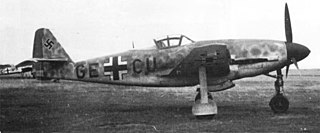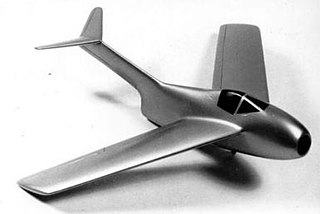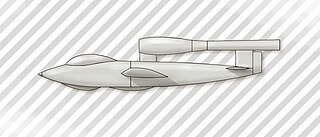
A pulsejet engine is a type of jet engine in which combustion occurs in pulses. A pulsejet engine can be made with few or no moving parts, and is capable of running statically. The best known example is the Argus As 109-014 used to propel Nazi Germany's V-1 flying bomb.

The Blohm & Voss BV 155 was a German high-altitude interceptor aircraft intended to be used by the Luftwaffe against raids by USAAF Boeing B-29 Superfortresses. Work started on the design as the Messerschmitt Me 155 in 1942, but the project went through a protracted development period and change of ownership, and prototypes were still under test and development when World War II ended.

The Messerschmitt Me 328 was a prototype pulsejet-powered fighter aircraft designed and produced by the German aircraft manufacturer Messerschmitt AG.

The first Messerschmitt Me 209 was a single-engine racing aircraft which was designed for and succeeded at breaking speed records. This Me 209 was a completely new aircraft whose designation was used by Messerschmitt as a propaganda tool. Although the aircraft was designed only to break speed records, it was hoped that its name would associate it with the Bf 109 already in combat service.

The Messerschmitt Me 309 was a prototype German fighter, designed in the early years of World War II to replace the Messerschmitt Bf 109. Although it had many advanced features, the Me 309's performance left much to be desired and it had so many problems that the project was cancelled with only four prototypes built. The Me 309 was one of two failed Messerschmitt projects intended to replace the Bf 109, the other being the 1943 Me 209 project.

The Messerschmitt Me 609 was a World War II German project which joined two fuselages of the Me 309 fighter prototype together to form a heavy fighter.

The Focke-Wulf Ta 183 Huckebein was a design for a jet-powered fighter aircraft intended as the successor to the Messerschmitt Me 262 and other day fighters in Luftwaffe service during World War II. It had been developed only to the extent of wind tunnel models when the war ended, but the basic design was further developed postwar in Argentina as the FMA IAe 33 Pulqui II. The name Huckebein is a reference to a trouble-making raven from an illustrated story in 1867 by Wilhelm Busch.

The Emergency Fighter Program was the program that resulted from a decision taken on July 3, 1944 by the Luftwaffe regarding the German aircraft manufacturing companies during the last year of the Third Reich.

The Messerschmitt P.1101 was a single-seat, single-jet fighter project of World War II, developed as part of the 15 July 1944 Emergency Fighter Program which sought a second generation of jet fighters for the Third Reich. A prominent feature of the P.1101 prototype was that the sweep angle of the wings could be changed before flight, a feature further developed in later variable-sweep aircraft such as the Bell X-5 and Grumman XF10F Jaguar.
The Messerschmitt Me 265 was a design project for a Zerstörer, produced by leading German aircraft manufacturer Messerschmitt in World War II.
The Blohm & Voss P 178 was a German jet-powered dive bomber/fighter-bomber of unusual asymmetric form, proposed during World War II.

The Messerschmitt P.1112 was a proposed German jet fighter, developed by Messerschmitt AG during the closing stages of World War II, and intended for use by the Luftwaffe. The progress of the war prevented the completion of a prototype before the fall of Nazi Germany. Its design, however, had a direct influence on postwar US Navy carrier fighters.

The Junkers EF 126 was an experimental fighter proposed by the German Miniaturjägerprogramm of 1944–1945, for a cheap and simple fighter powered by a pulsejet engine. No examples were built during the war, but the Soviet Union completed both unpowered and powered prototypes.

The Arado E.381 was a proposed parasite fighter aircraft. Conceived by Arado Flugzeugwerke in December 1944 for Germany's Luftwaffe during World War II, the E.381 was to have been carried aloft by and launched from an Arado Ar 234 "mother" aircraft. It would then have activated its rocket engine, which would have propelled it to attack Allied bombers. Development was cancelled due to lack of funds and official support.
The Messerschmitt P.1095 was a German military aircraft designed by Rudolf Seitz at the end of 1943. The aircraft used the wings, cockpit, and controls of the Me 262 and the tail surfaces and landing gear of the Me 309. The design was to have been powered by a turbojet engine located under the fuselage, and it was to have been armed with two nose-mounted MK 108 cannon.

The Blohm & Voss P 213 was a submission to the Miniaturjäger programme of the Luftwaffe Emergency Fighter Program towards the end of the Second World War. The Miniaturjäger was to be powered by a pulse jet but the programme was scrapped in December 1944.

The Messerschmitt P.1111 was a jet fighter/interceptor project, designed by Messerschmitt for the Luftwaffe near the end of World War II.

The Messerschmitt P.1110 was a design for a single-seat, high-altitude interceptor, prepared for the German Luftwaffe by the Messerschmitt aircraft manufacturing company, under the Emergency Fighter Program during the last months of World War II.

The Focke-Wulf Volksjäger, meaning "People's Fighter" in German, was a German emergency fighter project for the Luftwaffe. It was designed by Focke-Wulf industries towards the end of World War II as part of the defense effort against the devastating Allied bombing raids.

The Messerschmitt Me 262 was a German World War II fighter aircraft built by Messerschmitt in the later stages of the war, and under license by Avia post-war.

















